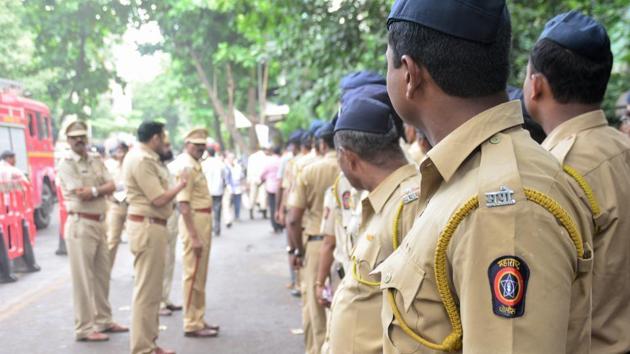Pradeep Sharma is back: Rise and fall of the fearsome 1983 batch of the Mumbai police
The first encounter any officer of this batch carried out was in 1993 when inspector Shankar Kamble took along the young sub-inspectors Salaskar and Sharma to catch Subash Makdawala
When a Mumbai police team of Ishaq Bhagwan, Raja Tambat, Fatehsingh Gaikwad and Yashwant Bhide gunned down dreaded gangster Manohar Arjun Surve alias Manya Surve outside Ambedkar college at Wadala in the city in 1982, few realised it would set a precedent for a promising bunch of police officers who were being trained at the time by the legendary Arvind Inamdar at the Police Training Academy in Nashik.

This bunch -- that included B Raju Pillai, Vijay Salaskar, Pradeep Sharma, Praful Bhosle, Ravindra Angre and Vinayak Saude – passed out in 1983 and many got their first postings at police stations across Mumbai, where they witnessed sporadic shootouts including the encounter killing of dreaded gangster Rama Naik in 1984.
The so-called 1983 batch rose to prominence in the mid- and late 1990s. In fact, the first encounter any officer of this batch carried out was in 1993 when inspector Shankar Kamble took along the young sub-inspectors Salaskar and Sharma, with the approval of then additional commissioner of police Hassan Gafoor, to catch the AK-56 wielding gangster Subash Makdawala. In the encounter that followed Sharma shot Makdawala dead.
From then on there was no looking back for these 1983 batch officers, who became trigger happy. Barring the late B Raju Pillai, who was responsible for 40 encounter killings, and Vinayak Saude, the rest revelled in being known as “encounter specialists.” Pillai preferred a low profile though he was the one who almost killed dreaded Chhota Rajan gangster DK Rao near Dadar. Rao survived the encounter with eight bullets lodged in his body.
With the Mumbai police desperate to check the gangs led by Dawood Ibrahim, Chhota Rajan, Arun Gawli, Amar Naik, Ashwin Naik and others, these officers were given a free hand and they
turned Mumbai into a killing field. Their media briefings were a farce: “We tried to arrest the gangster, he fired on us. We retaliated and he was killed.” No questions were asked ostensibly because they were killing underworld gangsters.
It appeared as if these officers were trying to upstage each other. The body count kept rising -- 50, 80, 100. Soon murmurs started, questioning the veracity of some of these encounters. There were also allegations that cops were playing favourites and were getting too closely involved in gangland rivalries. Slowly the tide turned against these feared cops and one after the other, they fell out of favour. The hunters became the hunted.
Praful Bhosale was suspended for his involvement in the murder of Khwaja Yunus, but was reinstated later. Ravindra Angre for various reasons was dismissed from service in 2014. Pradeep Sharma was dismissed for alleged underworld links in 2008, but was reinstated on August 16, 2017. Salaskar, who fell to the bullets of the 26/11 terrorists, too had his set of controversies.
One of the cops who has maintained a low profile, on condition of anonymity, told HT, “Encounter was once a necessary evil and everyone has to understand that it was an evil. But some were trigger happy and used it for their own vested interests.”
Statistics show encounters were not the only solution to fighting crime. Between 1999 and 2001, the detention of gangsters under the Maharashtra Prevention of Dangerous Activities (MPDA) Act was the highest — 1,290. During the period, the police seized 1,433 firearms, including several 9 mm pistols and AK-47s from gangsters, 212 persons were detained under MCOCA, and 896 members of the gangs of Dawood Ibrahim, Chhota Rajan, Arun Gawli, Amar Naik and others were arrested.
Though senior cops acknowledge the contribution made by these ‘encounter specialists’, they refuse to recognise them as the only officers who contributed to breaking the backbone of organised crime in Mumbai. Many were apprehensive the underworld gangs would return with full force following the ouster of the encounter cops, but such fears proved unjustified.
Top cops say the force always had dedicated and sincere officers in their ranks, who have ample experience tackling organized crime. A senior IPS officer, who spoke on condition of anonymity, said, “There are people in the force who have proved their capability more than once to investigate, detect and secure conviction for criminals. We don’t really need encounter cops.”
Stay updated with all the Breaking News and Latest News from Mumbai. Click here for comprehensive coverage of top Cities including Bengaluru, Delhi, Hyderabad, and more across India along with Stay informed on the latest happenings in World News.
Stay updated with all the Breaking News and Latest News from Mumbai. Click here for comprehensive coverage of top Cities including Bengaluru, Delhi, Hyderabad, and more across India along with Stay informed on the latest happenings in World News.





